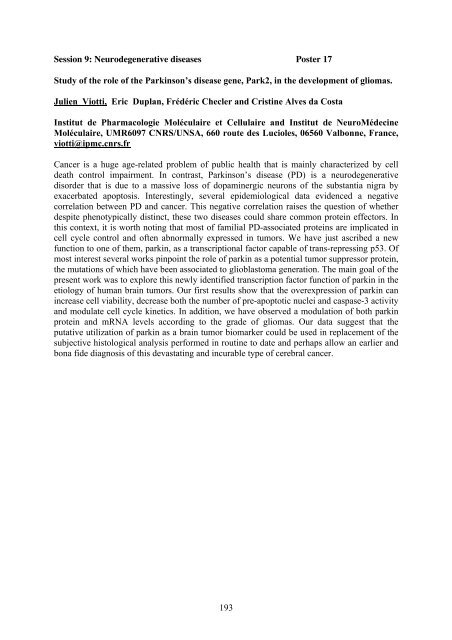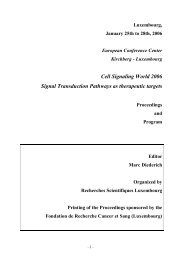Abstract book (download .pdf file) - Redox and Inflammation ...
Abstract book (download .pdf file) - Redox and Inflammation ...
Abstract book (download .pdf file) - Redox and Inflammation ...
You also want an ePaper? Increase the reach of your titles
YUMPU automatically turns print PDFs into web optimized ePapers that Google loves.
Session 9: Neurodegenerative diseases Poster 17<br />
Study of the role of the Parkinson’s disease gene, Park2, in the development of gliomas.<br />
Julien Viotti, Eric Duplan, Frédéric Checler <strong>and</strong> Cristine Alves da Costa<br />
Institut de Pharmacologie Moléculaire et Cellulaire <strong>and</strong> Institut de NeuroMédecine<br />
Moléculaire, UMR6097 CNRS/UNSA, 660 route des Lucioles, 06560 Valbonne, France,<br />
viotti@ipmc.cnrs.fr<br />
Cancer is a huge age-related problem of public health that is mainly characterized by cell<br />
death control impairment. In contrast, Parkinson’s disease (PD) is a neurodegenerative<br />
disorder that is due to a massive loss of dopaminergic neurons of the substantia nigra by<br />
exacerbated apoptosis. Interestingly, several epidemiological data evidenced a negative<br />
correlation between PD <strong>and</strong> cancer. This negative correlation raises the question of whether<br />
despite phenotypically distinct, these two diseases could share common protein effectors. In<br />
this context, it is worth noting that most of familial PD-associated proteins are implicated in<br />
cell cycle control <strong>and</strong> often abnormally expressed in tumors. We have just ascribed a new<br />
function to one of them, parkin, as a transcriptional factor capable of trans-repressing p53. Of<br />
most interest several works pinpoint the role of parkin as a potential tumor suppressor protein,<br />
the mutations of which have been associated to glioblastoma generation. The main goal of the<br />
present work was to explore this newly identified transcription factor function of parkin in the<br />
etiology of human brain tumors. Our first results show that the overexpression of parkin can<br />
increase cell viability, decrease both the number of pre-apoptotic nuclei <strong>and</strong> caspase-3 activity<br />
<strong>and</strong> modulate cell cycle kinetics. In addition, we have observed a modulation of both parkin<br />
protein <strong>and</strong> mRNA levels according to the grade of gliomas. Our data suggest that the<br />
putative utilization of parkin as a brain tumor biomarker could be used in replacement of the<br />
subjective histological analysis performed in routine to date <strong>and</strong> perhaps allow an earlier <strong>and</strong><br />
bona fide diagnosis of this devastating <strong>and</strong> incurable type of cerebral cancer.<br />
193




